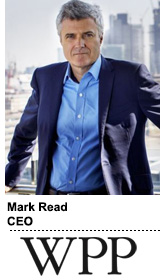
WPP may have a new CEO, but it still has the same old problems.
During its Q2 earnings report Tuesday, the holding company posted its first quarter of growth in a year, with like-for-like revenues up 1.6% for the first half of 2018 and 2.4% for Q2 to $9.6 billion.
But the company’s strongest region, North America, saw like-for-like revenues decline 2.9% to roughly $2.8 billion. And its data investment division, which saw a 0.8% dip in like-for-like revenue, also continued to struggle.
“We’re not declaring victory,” Mark Read, who was named CEO of WPP Monday after a four-and-a-half-month search by the board, told investors on the earnings call. “It’s early days. The starting point is that I’m optimistic about the future for WPP and for our industry.”
Despite optimism, Read has a lot of work to do to whip WPP back into shape. And his strategy may not be all that different from his predecessor, WPP founder and former CEO Martin Sorrell.
Sorrell, for his part, is not pleased at the delay in naming his successor.
“The company wasted five months looking for an external candidate, when there was little or no interest,” Sorrell told AdExchanger via email. “We’re effectively back to where we were on APRIL 3, with the same agreed succession plan.”
Game Plan
First on Read’s agenda is making WPP simpler to navigate – a process initiated by Sorrell during his tenure. While clients value WPP’s assets – its sprawling talent base, creative culture and technology and data relationships – they want easier access to it all, especially in local markets, Read said.
“I see a world with continued strong demand for what we do, but we have to change how we operate to grow in that world,” he said. “We need to focus on clients [and create] faster, integrated teams across the group. We need to better organize for growth.”
WPP is already on its journey toward simplification. Since Sorrell’s departure in April, the company has generated about $867 million by divesting 15 non-core assets, including Globant and AppNexus, which “raised significant amounts of money” for WPP, Read said.
“The goal is to tidy up the portfolio around the edges,” he said. “Some [divestitures] are relatively small, but disposing of them makes the group easier to manage.”
And collaboration between agencies in different disciplines is becoming more common, especially in big pitches. In a heavy review period, WPP has successfully won six out of its eight major pitches and defended three out of four incumbent accounts due to its ability to pitch with integrated teams.
“We are seeing progress in improving the win rate and focusing our best people and efforts on creative reviews,” Read said.
Meanwhile, WPP is being strategic in its acquisitions, looking only for companies focused on digital and technology. In August, WPP acquired Gorilla, a 400-person ecommerce firm that will integrate with Wunderman Commerce.
But whereas Sorrell was bullish on investing in data and technology, Read will focus on partnerships rather than acquisitions and using marketing technology from major players to help clients across strategy, creative and execution.
“We’ll be most focused on how we … can embed [technology] deeper in our offer,” he said. “That doesn’t mean buying or developing technology. It means leveraging the investment other people are making.”
But because Read’s strategy isn’t all that different from Sorrell’s, who groomed Read for succession, the former CEO warned that the board’s approach to the selection process slowed the company down even further in fixing some of its core issues.
“Mark and Andrew were the best internal combination then, as they are now,” Sorrell said. “They always were the succession plan. No need for the flawed recruitment process or wasting five months, particularly with your largest client in review.” That last gibe is a likely reference to Ford’s agency review.
Needs improvement
While WPP is working toward a simpler, more easily accessible model, it still has work to do in transforming legacy businesses and getting back to growth in the US.
WPP’s creative agencies, a core discipline of the group, are struggling to keep up with shifts in technology and client needs. Meanwhile, the data and investment management part of the business, which consists mostly of slow-growing market research firm Kantar, is also struggling due to new tech-savvy competition in the insights market.
Both trends are felt most acutely in North America, leading to WPP’s continued stalling in the region.
“In the US, it’s been four quarters now of disappointment,” WPP Chief Financial Officer Paul Richardson said on the call. “We’ve regained momentum strongly in the media business, but other business haven’t yet recovered. That’s the challenge we’ve got to take on.”
This post was syndicated from Ad Exchanger.


More Stories
Around the World: AI & Christmas, a Temu crackdown and Aussie influencers
Here’s a Short Roundup for This Week
Melanie Spencer a finalist in Campaign’s Agency of the Year Awards